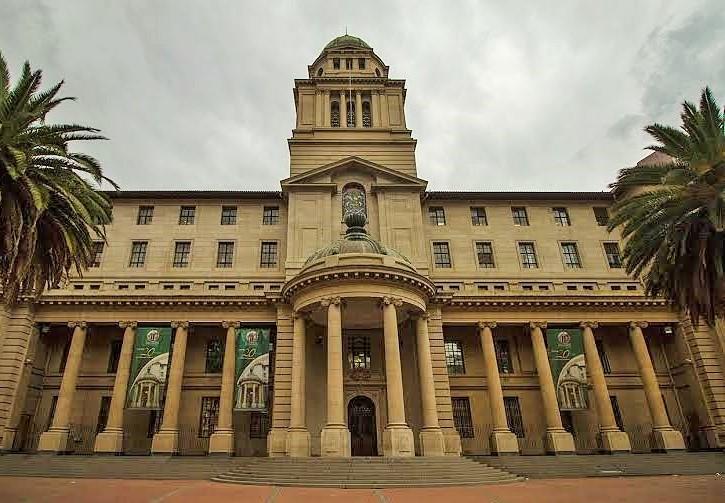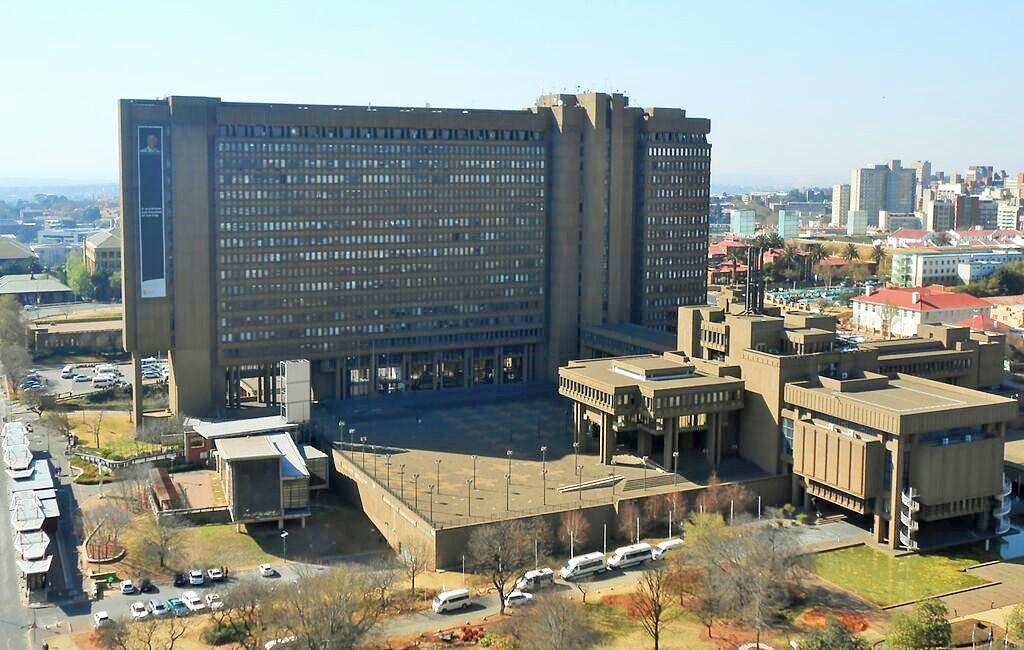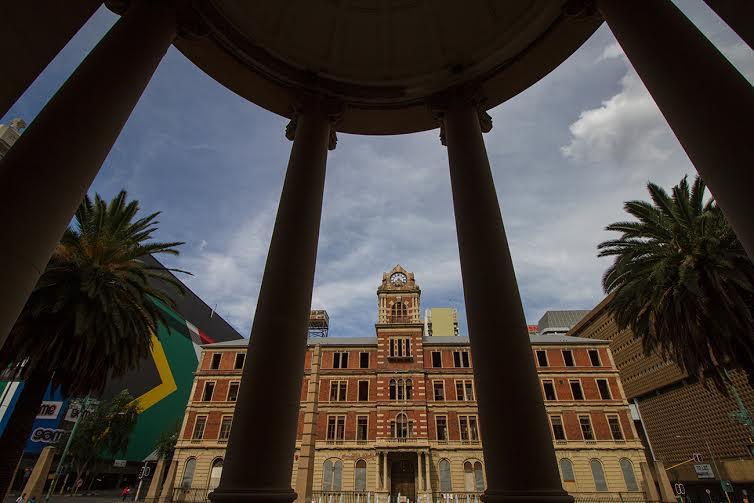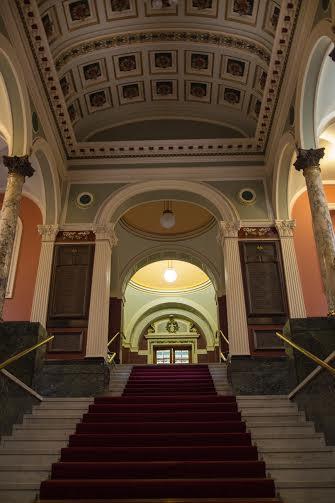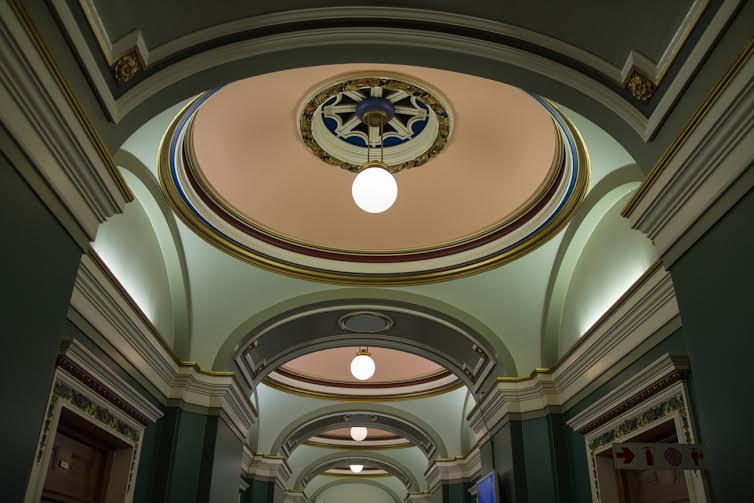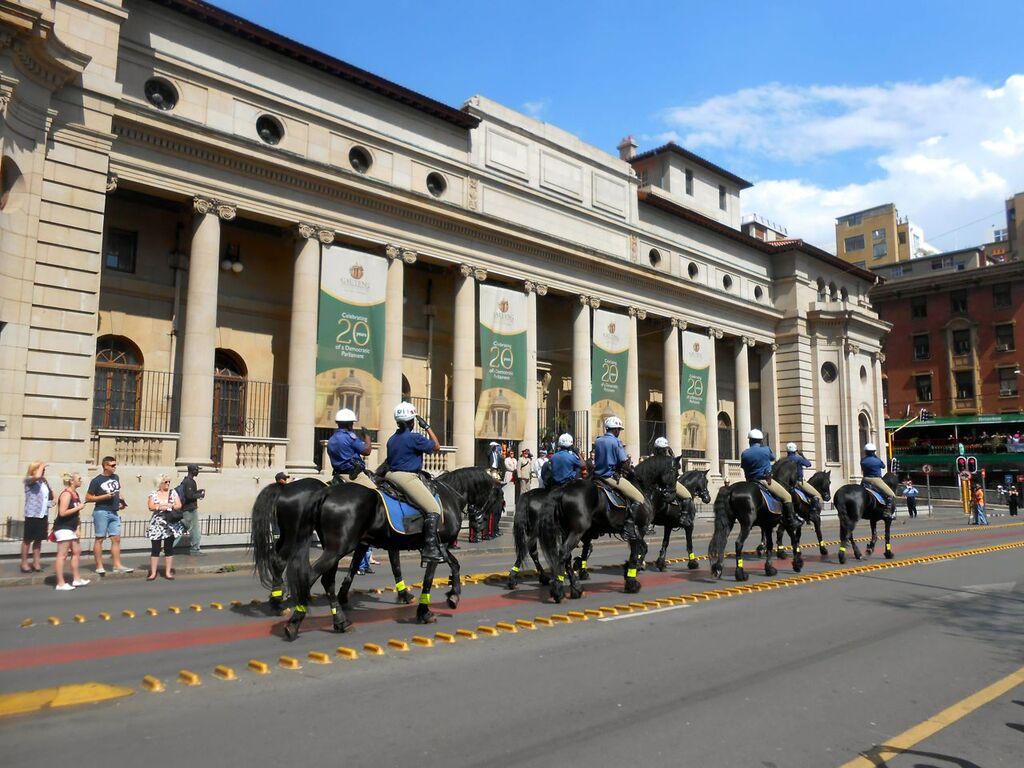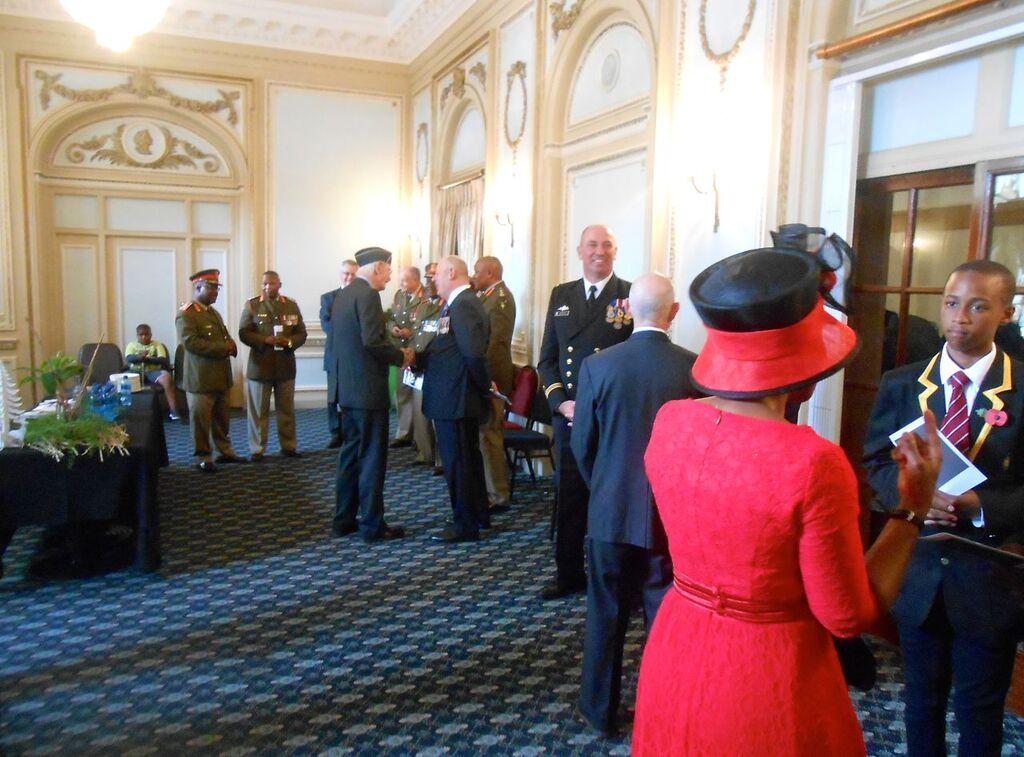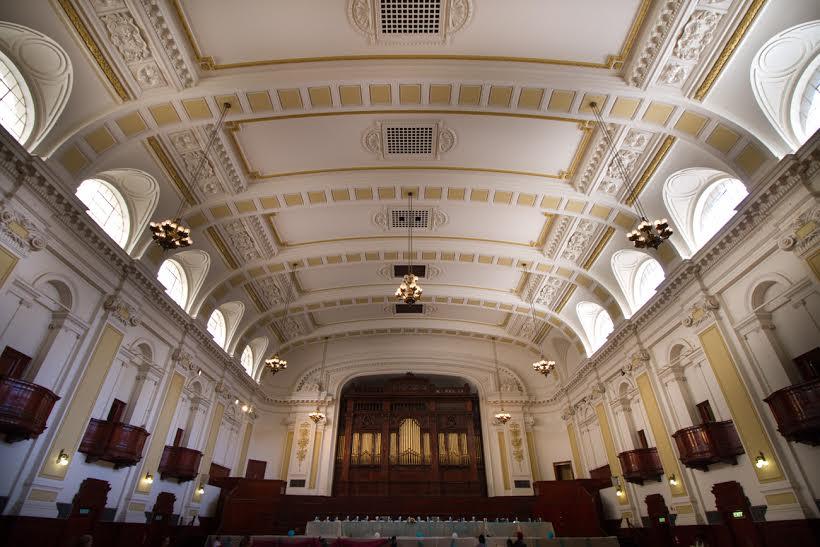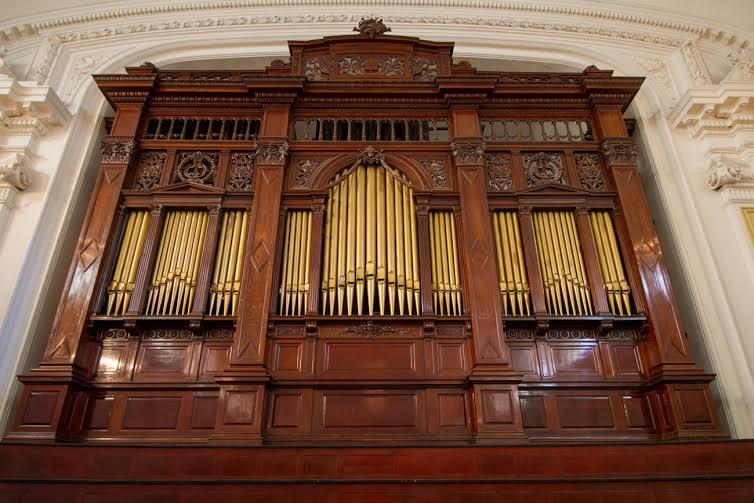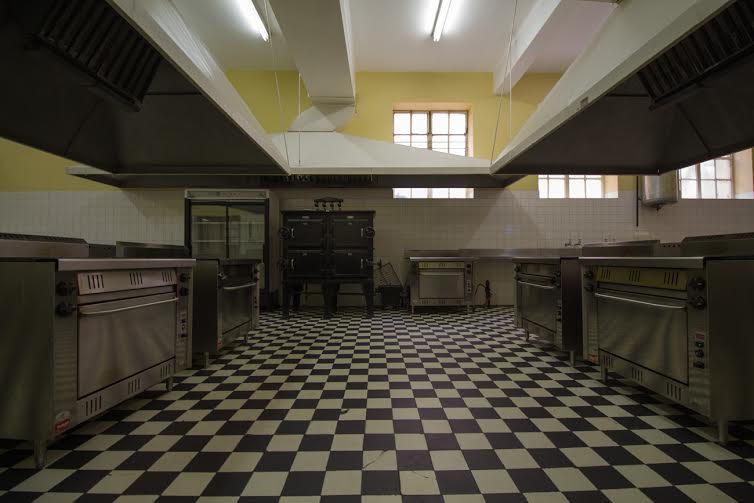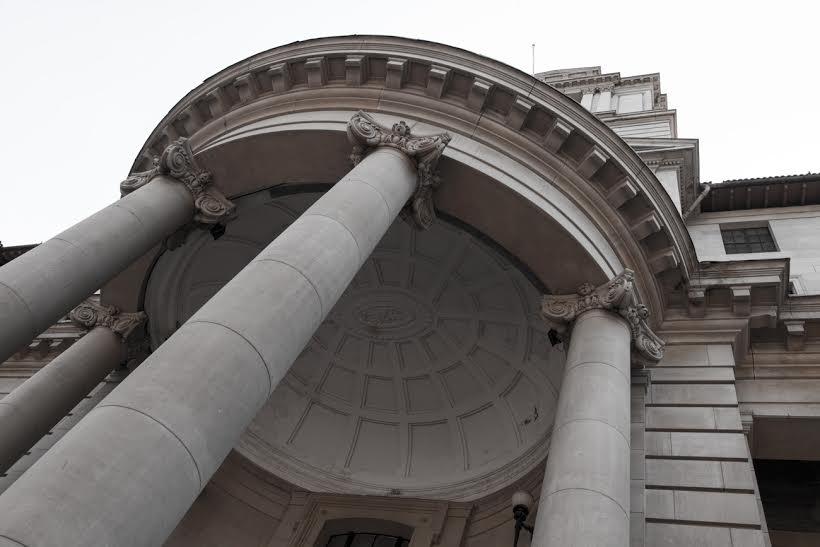
Disclaimer: Any views expressed by individuals and organisations are their own and do not in any way represent the views of The Heritage Portal. If you find any mistakes or historical inaccuracies, please contact the editor.
On a Saturday in mid October 2015, a group of Johannesburg Heritage Foundation members gathered in Rissik Street in front of what older Johannesburg citizens knew as the Johannesburg City Hall. Today the building is the Gauteng Legislature. We met on the City Hall steps, standing on what was once the historic market square, laid out in Johannesburg in 1886. It is a space that has seen vast transformations, buildings have come and gone, ideas about city centre layouts have altered. Once the Market Square was the heart of the City and had the distinction of being the largest market square in South Africa. It was the place of commerce, an actual market, ox wagons carrying farm produce outspanned here.
An old postcard of Johannesburg's Market Square
In my lifetime the City Hall Steps was the space for pigeons and protests, evangelists thundering forth from the Rissik Street frontage, in the shadow of the solid sandstone walls. This was the point where royalty and dignitaries given a proper civic welcome by the mayor. I grew up in Johannesburg and for me the City Hall was the most important, overwhelmingly impressive building in the city. It is a place and space filled with memories of a lifetime. The location of the City Hall in the space bounded by Rissik, Albertina Sisulu (Market), Helen Joseph (President) and Simmonds Streets.
Gauteng Legislature Main Facade (Mark Straw)
This was the seat of Johannesburg City Government from 1915 to 1972. Today it is no longer the City Hall and no longer defines the heart of Johannesburg. The edifice is still monumental but it has been transformed into the home of the Gauteng Legislature and the seat of provincial government. Today the building has very little to do with the City of Johannesburg as the City sold this heritage gem along with the Library gardens and the underground parking garage for R20 million to the Gauteng Provincial Government in 2001 and city government relocated to the Civic Centre on the Braamfontein hill to the north in 1972.
Civic Centre (The Heritage Portal)
The old City Hall is still a Heritage building in the “A” category of JHF (meaning do not demolish under any circumstances) and has an aesthetic and historical significance that makes it a building that has to be preserved and celebrated, as indeed it is, despite its shifting phases of transition from Town hall, to place of City government, to two decades of being a neglected hulk to a brilliant rebirth and resurrection as a place of provincial government.
I had to adjust my frame of reference from local to provincial. It was a quiet Saturday afternoon with few people about. Fifty years ago the heart of Johannesburg was a bustling hub – the space filled with dense bustling crowds, the sounds of busy people moving about their chores, commercial activity abounded, burly buses jostled cars, department stores vied with interesting small specialist shops. The old tram terminus was located behind the City Hall on Market Square (my mother insisted on taking me on one of the last tram journeys to Kensington, her directive, “now remember this historic occasion”).
On a clear Saturday 2015 afternoon, as we stood on the square looking across at the ruined shell of the Rissik Street post office, memories of exciting childhood shopping expeditions to town resurfaced.
Rissik Street Post Office from the Gauteng Legislature (Mark Straw)
Now under the auspices of the Johannesburg Heritage Foundation, the purpose of our meeting was not a political protest or to listen to a sermon, but instead to be taken on a tour of the building by the distinguished Johannesburg architects, Marcus Holmes and Mira Fassler who were commissioned in 1994 to restore the building and effect the conversion from the white elephant, mothballed relic to repurposed and grand Gauteng council chambers and committee rooms. If one is to find vitality and purpose to provincial government it is here. It was certainly a project that kicked off in 1994 with youthful energy speed and boundless faith in the future of democratic government. The decision had been taken to move provincial government from Pretoria to Johannesburg and this august empty building was the choice and the vision of Neil Fraser and Nigel Mandy and the City Council of 1993. Here was a grand opportunity to anticipate democracy, reclaim a purpose for the inner city and proclaim the City Hall as the heritage site which would spearhead inner city revival. How did this project look after 20 years? In brief the answer is remarkably well despite the vicissitudes of inner city decay, change, seismic demographic ships and now revivals.
The tour promised much:
The Gauteng Legislature (previously the City Hall) is one of our most important buildings. It was the seat of municipal government from 1910 to 1972, and the focal point of many celebrations, including our golden jubilee and those marking the end of the First and Second World Wars. But it was also an important site of political expression and protest – initially robust and rowdy, but later silent and dignified.
In 1994 Fassler Kamstra & Holmes Architects were tasked with transforming this old Edwardian building with “rat infested tunnels and ducts saturated with the dust of ages” into a modern and functioning home of the Provincial Legislature of Gauteng. By stripping away 80 years of accumulations, Mira Fassler and Marcus Holmes exposed the historic shell, and then enriched the original architectural details with a palette of “veld-bound earth reds and sun-burst ochres”.
Join the architects in exploring the building, its history, and the process to transform it into the heart of our vibrant city.
The tour was a rare treat as this grand old colonial monumental building is usually inaccessible and heavily guarded; we were not sure that photographs would be allowed. The battering of the Legislature by the Economic Freedom Fighters in 2014 had made for a jumpy atmosphere that still lingered. Obstacles to entry start with chained gates, locked gates and closed shutters. Getting into the building was the first challenge, though prior permission had been sought and given from a dizzy height of security authority. The security blanket together with an amiable helpful ineptitude, meant that the route was serendipitous, as we trailed through the corridors and rooms which were open and then back tracked up and down stairs to reach the locked recesses and chambers and then waiting for the permission button to be pressed and keys to arrive. For Fassler and Holmes the building was completely familiar territory and an opportunity to reflect on their achievements and proudly show off their work.
Johannesburg City Hall under construction (Wikipedia)
A Touch of Civic History
The Musikers (Historical Dictionary of Greater Johannesburg) tell us that the first purpose built administrative building of Johannesburg was the Tin Temple, hastily erected in Plein Park (today’s Atwell gardens) in 1903. But Johannesburg needed something better and more in keeping with its conscious positioning as a model, modern emerging city of the British Empire, in keeping with other colonial centres such as Ottawa or Melbourne.
The plans for a Town Hall date back to 1910. The Cape Town architectural firm Hawke and McKinlay had won the 1909 design competition. The builder was the well-known competent Mattheus Meischke (who had also constructed the Rissik Street Post Office). The cost of the grandiose project was £503 000 and it was the largest and most expensive building in the city at that time. Hawke and McKinlay specialized in monumental buildings (1906, the University Buildings, Queen Victoria Street, Cape Town; the Supreme Court Building Cape Town and the Law Courts and Museum of Bloemfontein). Desiree Picton- Seymour describes the Johannesburg City Hall, as “the most grandiose of this firm of architect’s various official buildings, it is by no means the most pleasing. Of unwieldy proportion….” (p 355). De Waal comments on the massive proportions of the building – “it is not tall but broad”. The style is Beaux Arts and strongly neo-classical.
On 29 November 1910, the City Hall's corner stone was laid by Prince Arthur, Duke of Connaught and Strathearn. Completed in January 1915, the City Hall was officially opened on 7 April 1915 by the South African Governor-General Lord Buxton (this event is recorded in a marble framework). I liked the brass plaque recording the mayors and councillors of Johannesburg in those crucial years of construction. It is a roll call of the city fathers: that succession of city mayors - Carr, Gooch, Gunn, Tucker, Thompson, Graumann, Hofmeyr, Ellis Boustred, and Anstey – all white males who made who made their mark and left a city legacy.
Brass Plaque recording Mayors and Councillors (Kathy Munro)
From Town to City
Remember to that when the City Hall buildings were constructed, Johannesburg was only a town (as yet, no university and no cathedral) but it was a town of promise, growing confidence, a burgeoning population, a more substantial financial base and confident ambitions and this was a structure that exudes civic status and proclaimed permanence.
Neame (City Built on Gold) records that the new Town Hall was used for the first time on the evening of January 26 1915 when delegates from Belgium spoke at a public meeting in support of the Allies in the Great War. Laid wording on the front steps remind us of the First World War connection, “Lest we Forget”.
Lest We Forget
Today those three words have been given another context, reminding us that a democratic dispensation has been ours now for two decades and we are celebrating 20 years of democratic local government.
Another brass honour board marks the shift from town to city status achieved in 1928. Commemorative plaques still preserved, give us those thumbnail summaries of city history. 1936 was the 50th anniversary of the city and city festivities included the illumination of the City Hall in lighting and bunting.
The image above shows an extract from Anna Smith’s book Pictorial History of Johannesburg, 1955, published by Jutas. There is a connection between achieving City status and the presence of St Mary’s Anglican Cathedral on Noord Street. The University of the Witwatersrand was also established with City support in 1922 at Milner Park (a citizens meeting to campaign for this development was led by Major John O’Hara). In British imperial thinking and traditions it was the cathedral in a town that made a town qualify for city status. The picture is worth studying closely as it shows the colonnaded frontage and the domed front vestibule on Rissik Street but in 1928 the turret and clock tower had not yet been added. We can grasp the intention of the architects and the cylindrical columns have a greater aesthetic appeal.
A Place of Protest
The phrase 'Lest we Forget’ reminds us to recall the City Hall as a place of political protest, opposing apartheid and its excesses, in the 1950s and 1960s. Below is a photograph of members of the Black Sash protesting in front of the Johannesburg City Hall, and this they often did on a daily basis, in 1960 in disciplined, silent reproach against the Verwoerd government.
Black Sash Protest at the City Hall
Going Inside
The main staircase leading form the principal rather small circular foyer on the Rissik Street side is imposing and grand. One is captivated by the mottled marble, red carpeted stairs, the deep green walls and your eye is drawn to the Corinthian columns above and the barrel vaulted, finely decorated ceiling. From this point one is entirely captivated by the restoration and renewal effected by Holmes and Fassler. Their extraordinary use of paint gives life and grandeur in highlighting the details through colour contrasts. Their palette is a rich array of gleaming gold, earthy ochre, pastel green, plush red, subtle pink contrast against the marble and jade green stone, brass railings and cast iron balustrades. Johannesburg colours are after all gold and green. The riot of colour brings a renaissance style grandeur that is utterly appropriate for conveying a sense of place. The old city coat of arms with its three stamp dollies remains etched and almost eternally trapped in the iron work .
Main Staircase (Mark Straw)
Extraordinary use of Paint (Mark Straw)
Three shades of blue turn a recessed ceiling into a work of art; light is enhanced and reflected on the white and gold of the fine plaster work (Photographed by Kathy Munro)
Spot the Johannesburg coat of arms on this iron balcony (Kathy Munro)
And embedded above this scrolled plaster cherub (Kathy Munro)
In 1937 an additional floor was added to the building which involved the dismantling of the tower, stone by stone and its later rebuilding. In 1979 the City Hall was designated a National Monument, however the brass plaque proclaiming that recognition has long since gone missing.
Spot the missing plaque on the fine stone walls behind the abandoned bottles (Kathy Munro)
Specific features of the building with the red pan tiled sloping roof, the chimneys, and copper covered dome and those columned porticos, the window proportions make this an Edwardian building, emphatically historical in its symbols and features. It is colonial but also echoes an Italian almost Florentine presence, it brings Renaissance traditions to the town on the dusty Highveld and at an early date set the aspirations for what the city fathers so self importantly commissioned. All these historical antecedents and references are celebrated by Holmes and Fassler in the recovery and restoration of the interior.
The Restoration
Holmes explained that the structure of the monumental building filling that section of Market Square bounded by Market St, President St, Harrison and Rissik Streets is a series of three buildings and hence conversion and modernization demanded considerable technical inputs, for a team that worked on a tight deadline in 1994. Holmes pointed out how difficult it sometimes is for architects to achieve perfection, with damaged stone work (there was a bomb blast in front of the City Hall in 1988) being patched by contractors with cement infill. There were particular challenges around inner courtyards and getting rid of decades of pigeon guano. Today the pale lemon walls and the stained glass windows look out onto tranquil almost secret havens.
The interior detail as seen in the solid wooden doors, the wooden panelling, the brass door handles, the decorated surrounds impress their colours and the lightness and sureness of taste and touch. The stained glass windows when seen from the interior are a delight and the design here offers a hint of the art nouveau style.
Holmes explained that what was remarkable about the project to bring the Gauteng legislature to Johannesburg was the speed of the conversion, taking instant decisions and having a generous budget. The deadline of a mere eight months was tight but it was met. Meetings with contractors were often held at three in the morning. The contracting partners were Murray and Roberts and L T A. What Holmes and Fassler wanted was to return the building to its neo-classical root and this meant eliminating the additions and insensitive office changes over the 20th century decades.
Fassler led the group through the key assembly, executive rooms, committee rooms, lounges and media rooms of the Gauteng Legislature. Again the success of the rooms lies in the attention to detail, the mix of colours and the use of quality material. She explained how her colour range of over 100 hues made for experimentation but also an opportunity to use paint and colour variety to emphasise texture and perspective on the wall and ornate plaster surfaces and decorative features. The brilliant colour combinations draws out the best of the historic rooms and gives them remarkable new life.
Here you see rich golds, verdant greens, baby blues and cherry reds in wonderful harmony and inviting one to reach, touch, and feel the surfaces (Kathy Munro)
What was the old Selbourne Hall is now the Gauteng Provincial Legislature. One is reminded indeed that there were three halls within the four story building, the City Hall, the Selbourne Hall and the Duncan Hall. At one time the Duncan hall, was a tea patio Holmes enthused. Dances and parties were held in the Selborne Hall.
Gauteng Legislature (Kathy Munro)
Old panelling was retained in these democratic public spaces but the new modern furniture and the positioning of the curved desks, the latest in sound equipment and plenty of room for a media presence gives the old hall an august and fitting place of local provincial government. It was a R78 million project, with the focus on the reconversion and revival of the interior. Sadly the exterior of the City Hall did not receive the same attention and still needs a great deal of restoration.
I was particularly keen to see what had become of the old rates hall of the City of Johannesburg, as I recall being sent by my parents, when I was a teenager with municipal bill and cash in hand to pay the monthly rates at the counters. Today this hall is a space for relaxation, exhibitions and entertainment. The counters have been retained but the public art reminds us how far we have come as an inclusive democracy in two decades.
Old Rates Hall (Kathy Munro)
The City Hall is located at the rear of the building and almost constitutes a separate entity and that face at the rear of the building on Simmonds Street is far more modest and I think more attractive than the Rissk Street Façade.
The Harrison Street Rear Elevation (The Heritage Portal)
We gathered in the Mayoress’ parlour for the talk by Fassler and Holmes on the challenges they faced back in 1994. Here there are more intimate reception rooms where once guests to Johannesburg were welcomed and received. The décor is classical and feminine. The blue and gold colours highlight the garlanded flower swags and the classical cameo head in the arches above the doorways; the plaster work shows total professionalism in the craftsmanship. Here one could be in Regency Brighton.
The Mayoress and Dignitaries in the Mayoress’ parlour during the 2014 Remembrance Sunday Commemorations (The Heritage Portal)
It is worth taking note of the intricate mosaic flooring throughout the building, laid in geometrical circle and square shapes, durable and fit for purpose. One could have stepped into a Roman villa say in Split on the Dalmatian coast or in Asia Minor. Floors tell you as much about historic references and antecedents as walls. There is nothing finer than a well laid floor, despite the fact that the foyer of the City Hall was filled with those inflatable bubble jumping castles for kids.
Mosaic Floor (Kathy Munro)
Another Mosaic Floor (Kathy Munro)
The City hall is a place of pomp and circumstance, a large hall seating 1400 for concerts, the rich decoration of plaster, gilt detailed reliefs, woodwork across the broad expanse of the hall also merit attention but here you need a telephoto lens. The lemon gold contrasts with the white plaster panels and draws your eye to the choice seating in a box at first floor level and the balcony above. It is a grand concert hall with a theatrical feel.
The fine organ with over 6000 pipes was the largest in Africa. It was built by the organ builders Norman and Beard and weighs 60 tons. I remember concerts with massed choirs and this was the home of the Johannesburg Symphony Orchestra (until crime and the anxiety about coming into town at night led to a relocation of concerts at the Linder auditorium on the Wits campus). Many a political meeting was held in the Johannesburg City Hall and, as mentioned earlier, it was not unusual for protests to gather outside.
The City Hall is the only part of the building that remains a facility on hire for the citizenry of the town. You can host your wedding or your party in the great City Hall. The City website informs us that the City Hall seats 1 400 for concerts, 500 for dances, 700 for banquets and 1 000 for buffets. It is a very long time since the Johannesburg Symphony Orchestra performed in the City Hall or massed choirs performed in concert.
Inside the City Hall (Mark Straw)
The Famous Organ (Mark Straw)
During my visit there was an expectant air of a party about to happen in the hall with tables set for wedding guests. Instead of the organ in full sound, there was an African band tuning up with drums and amplifiers. A rare detour into the kitchens showed an engine room that catered for the hundreds. There’s a mix of older and new stoves, ovens and grills and the older equipment was imported.
A Section of the Kitchen (Mark Straw)
I also remember the steps leading to the City Hall as the place where charitable booksales were held by the good ladies who raised funds for the Homes and Orphans Fund and other worthy causes. This was where I first found a pleasure in finding a rare old book!
Perhaps the biggest surprise of the building is firstly the restoration’s survival. The project aimed to give new life to a different local government and is there to be celebrated some twenty years after the project commenced. It is an excellent example of reposition and reuse of a heritage building. Secondly, and more importantly, the interior splendour, so deliberately and audaciously celebrated in these rich colours gives august majesty but not sombre presence to these old halls which are now new government chambers. Thirdly, for me, the success of the interior design with of course all public art that speaks to the South African circumstances, gives one a new appreciation for the exterior and to reflect that vision of civic pomposity of the original 1910 Cape Town architects was not so misplaced after all. Let’s live in hope that one day the exterior will receive the same magnificent restoration as the interior.
Comments will load below. If for any reason none appear click here for some troubleshooting tips. If you would like to post a comment and need instructions click here.

